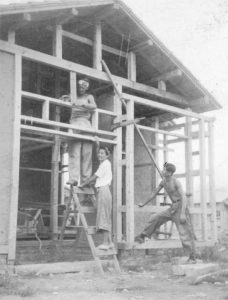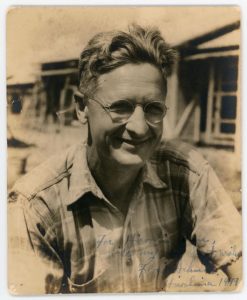Documenting Hiroshima 80 years after A-bombing: In August 1949, Floyd Schmoe, students work hard to build Peace Houses
Feb. 11, 2025
by Minami Yamashita, Staff Writer
In August 1949, an American man and Japanese students worked on a major construction project in Hiroshima City, which was still in the process of recovery. Leading the efforts was Floyd Schmoe, an American forestry researcher who died in 2001 at the age of 105. Mr. Schmoe visited the city with 10 acquaintances from the United States and Tokyo to build houses for those who had lost their homes in the atomic bombing by the U.S. military.
The Chugoku Shimbun reported on the thoughts of Mr. Schmoe, who had arrived in the city on August 4, related to his efforts to build houses in the city. According to the article, Mr. Schmoe said he was happy his wish had finally come true, and that he wanted to work hard until the Hiroshima houses were constructed. The article added that around 30 students from Hiroshima would join the effort.
In support of Japanese-Americans
With a son-in-law of Japanese-American descent, Mr. Schmoe had been working to support Japanese-Americans since the war. Deeply saddened by the atomic bombings carried out by the United States, he had visited Hiroshima for the first time in 1948, during which time he witnessed the lives of citizens who did not have access to sufficient housing. Back in the United States, he raised $4,300 for construction of “Houses for Hiroshima” and returned to Japan after preparing such materials as nails and glass.
“He had a very gentle nature but a fervent desire for peace,” said Tomiko, 95, Mr. Schmoe’s widow who lives in the U.S. city of Seattle. She had joined the effort to build houses in Hiroshima before they were married. In 1948, when she was a university student, she heard about the plan from Mr. Schmoe himself at a meeting of a volunteer group in Tokyo. Losing her own house in the Great Tokyo Air Raid, she appreciated the significance of the volunteer work.
Mr. Schmoe and his group stayed at the Hiroshima Nagarekawa Church (in the city’s present-day Naka Ward) while they worked in the area of Minami-machi (now part of Minami Ward) during the day. They carried lumber and hammered nails under the supervision of carpenters. From the United States, young elementary school teachers and pastors also participated.
Tomiko said, “Young men and women sharing the same goal worked together in the summer heat of Hiroshima, becoming good neighbors irrespective of nationality.” In October, Minami Peace Housing row houses were completed and turned over to the city government. A garden was created on the grounds, where two buildings stood, with the words “Pray for Peace” carved into a stone lantern.
Fifteen buildings with 21 units completed
Thereafter, Mr. Schmoe and his group continued to build houses in other areas, including the Eba district (in Hiroshima’s present-day Naka Ward). More than $30,000 had been donated from around the world, leading to the construction of 15 houses with 21 units and meeting spaces by 1953. At some point, an English sign was erected at the construction sites that read, “To build understanding, by building houses, that there may be peace.”
In August 1949, Norman Cousins, editor-in-chief of a literary magazine published in New York City who died in 1990 at the age of 75, also visited Hiroshima. He met with Reverend Kiyoshi Tanimoto, an A-bomb survivor who had traveled to the United States the previous autumn. Mr. Cousins was helping with the city’s peace petition signature campaign to call on U.S. President Harry S. Truman to take action to prevent war.
Mr. Cousins visited the Hiroshima War Orphans Foster Home and published a report titled “Hiroshima Four Years Later” later that year in September after his return to the United States. In the report, he advocated for the idea of “moral adoptions.” He wrote, “By moral adoptions I am thinking of Hiroshima children who would be adopted by American families and who would carry the names of the people adopting them. The children would continue to live in Japan … but the American families would be responsible for their care and upbringing.”
The report had great impact. “Our office was flooded with letters offering to care for the orphans,” reported the Chugoku Shimbun dated September 29, 1949. This led to the “moral adoption campaign,” in which American citizens sent money to support the lives of A-bomb orphans.
(Originally published on February 11, 2025)
In August 1949, an American man and Japanese students worked on a major construction project in Hiroshima City, which was still in the process of recovery. Leading the efforts was Floyd Schmoe, an American forestry researcher who died in 2001 at the age of 105. Mr. Schmoe visited the city with 10 acquaintances from the United States and Tokyo to build houses for those who had lost their homes in the atomic bombing by the U.S. military.
The Chugoku Shimbun reported on the thoughts of Mr. Schmoe, who had arrived in the city on August 4, related to his efforts to build houses in the city. According to the article, Mr. Schmoe said he was happy his wish had finally come true, and that he wanted to work hard until the Hiroshima houses were constructed. The article added that around 30 students from Hiroshima would join the effort.
In support of Japanese-Americans
With a son-in-law of Japanese-American descent, Mr. Schmoe had been working to support Japanese-Americans since the war. Deeply saddened by the atomic bombings carried out by the United States, he had visited Hiroshima for the first time in 1948, during which time he witnessed the lives of citizens who did not have access to sufficient housing. Back in the United States, he raised $4,300 for construction of “Houses for Hiroshima” and returned to Japan after preparing such materials as nails and glass.
“He had a very gentle nature but a fervent desire for peace,” said Tomiko, 95, Mr. Schmoe’s widow who lives in the U.S. city of Seattle. She had joined the effort to build houses in Hiroshima before they were married. In 1948, when she was a university student, she heard about the plan from Mr. Schmoe himself at a meeting of a volunteer group in Tokyo. Losing her own house in the Great Tokyo Air Raid, she appreciated the significance of the volunteer work.
Mr. Schmoe and his group stayed at the Hiroshima Nagarekawa Church (in the city’s present-day Naka Ward) while they worked in the area of Minami-machi (now part of Minami Ward) during the day. They carried lumber and hammered nails under the supervision of carpenters. From the United States, young elementary school teachers and pastors also participated.
Tomiko said, “Young men and women sharing the same goal worked together in the summer heat of Hiroshima, becoming good neighbors irrespective of nationality.” In October, Minami Peace Housing row houses were completed and turned over to the city government. A garden was created on the grounds, where two buildings stood, with the words “Pray for Peace” carved into a stone lantern.
Fifteen buildings with 21 units completed
Thereafter, Mr. Schmoe and his group continued to build houses in other areas, including the Eba district (in Hiroshima’s present-day Naka Ward). More than $30,000 had been donated from around the world, leading to the construction of 15 houses with 21 units and meeting spaces by 1953. At some point, an English sign was erected at the construction sites that read, “To build understanding, by building houses, that there may be peace.”
In August 1949, Norman Cousins, editor-in-chief of a literary magazine published in New York City who died in 1990 at the age of 75, also visited Hiroshima. He met with Reverend Kiyoshi Tanimoto, an A-bomb survivor who had traveled to the United States the previous autumn. Mr. Cousins was helping with the city’s peace petition signature campaign to call on U.S. President Harry S. Truman to take action to prevent war.
Mr. Cousins visited the Hiroshima War Orphans Foster Home and published a report titled “Hiroshima Four Years Later” later that year in September after his return to the United States. In the report, he advocated for the idea of “moral adoptions.” He wrote, “By moral adoptions I am thinking of Hiroshima children who would be adopted by American families and who would carry the names of the people adopting them. The children would continue to live in Japan … but the American families would be responsible for their care and upbringing.”
The report had great impact. “Our office was flooded with letters offering to care for the orphans,” reported the Chugoku Shimbun dated September 29, 1949. This led to the “moral adoption campaign,” in which American citizens sent money to support the lives of A-bomb orphans.
(Originally published on February 11, 2025)









